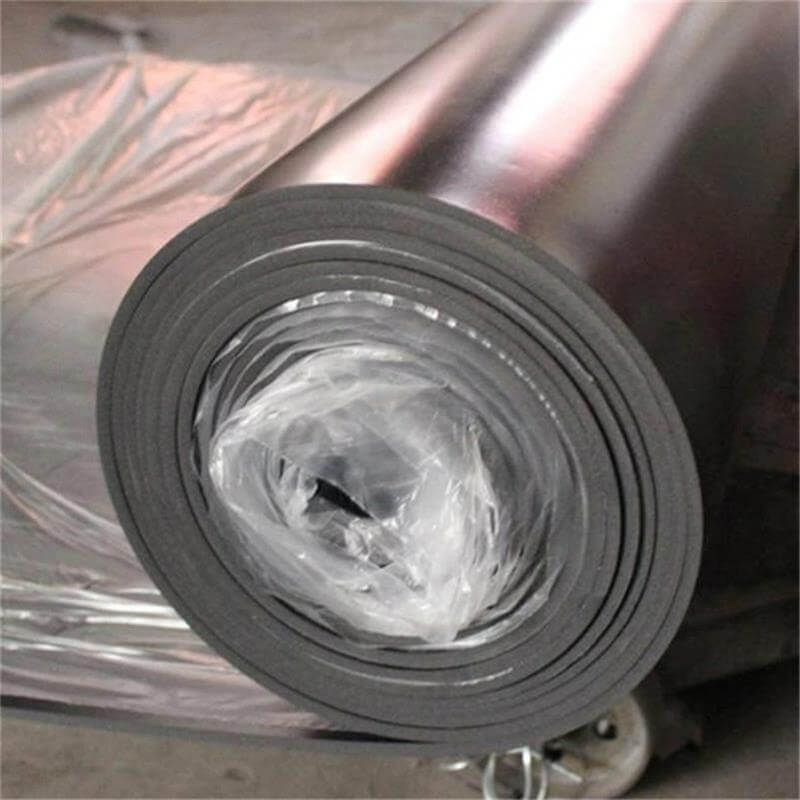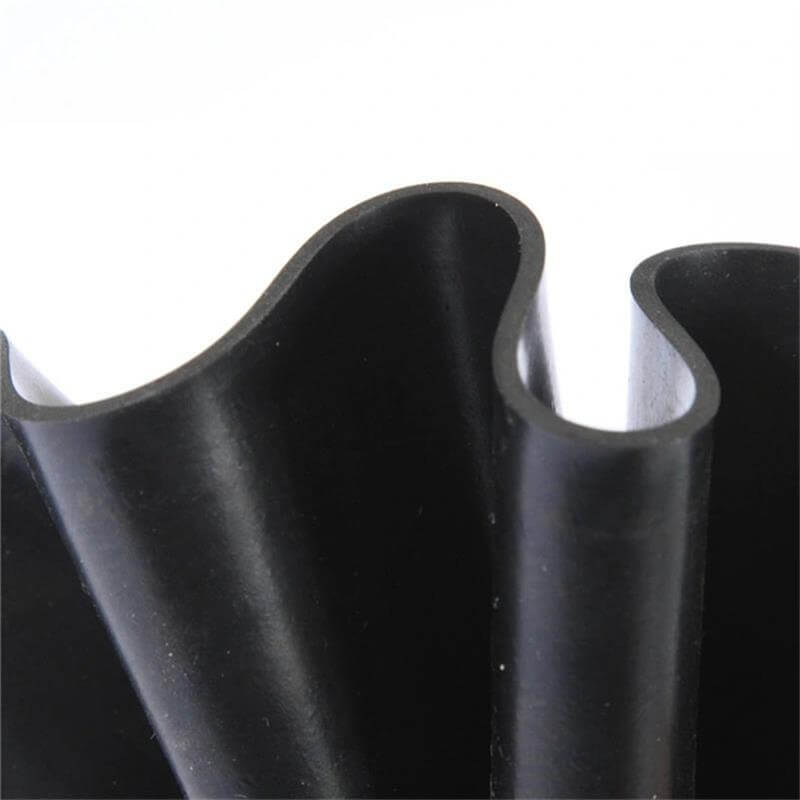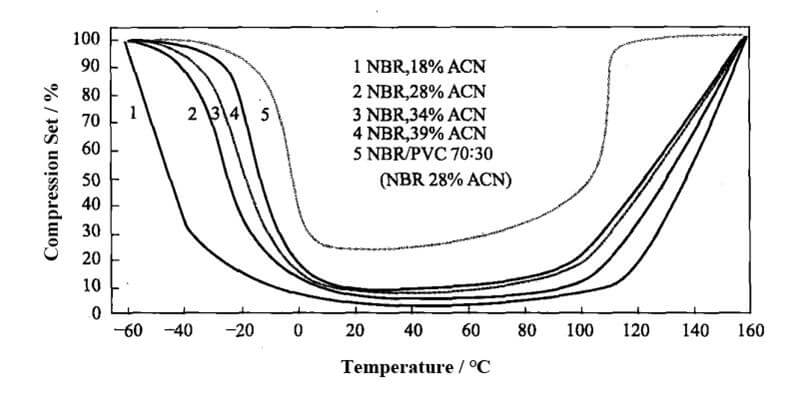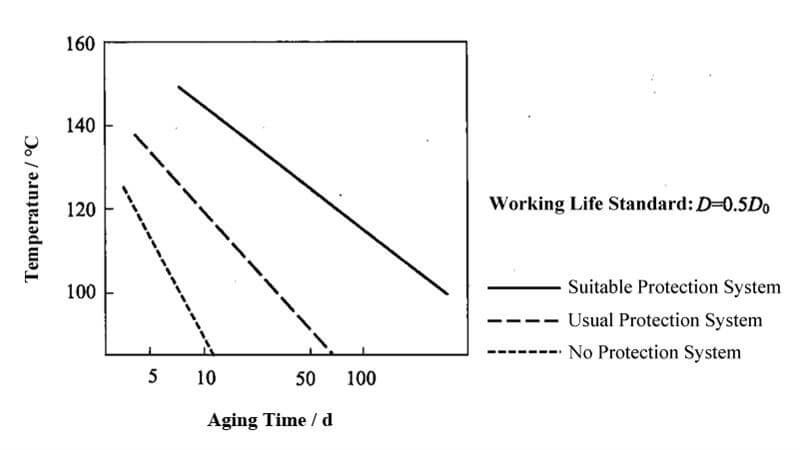NBR rubber (also known as Nitrile or Buna-N) is a copolymer of acrylonitrile and butadiene monomers. It is a kind of polymer elastomer obtained by emulsion or solution polymerization of two monomers, butadiene, and acrylonitrile (ACN). Most of the nitrile rubber used in industry is ordinary nitrile rubber obtained by the emulsion method which is a polar, unsaturated, and amorphous rubber.

NBR Molecular Formula
Table of Contents
Types of NBR Rubber
There are many kinds of NBR rubber, usually divided into dozens of varieties according to acrylonitrile content, Mooney viscosity, polymerization temperature, etc. According to different uses, it can be divided into two categories: general type and special type. Special types also include carboxyl NBR rubber, partially cross-linked NBR rubber, nitrile and polyvinyl chloride co-precipitated rubber, liquid NBR rubber and hydrogenated NBR rubber. According to the polymerization temperature, it is divided into: high temperature polymerized NBR rubber, using potassium persulfate as initiator, 30~50 ℃ polymerization, also known as hard NBR rubber; low temperature polymerized NBR rubber, using hydrogen peroxide cumene-ethylenediamine Sodium tetraacetate-ferrous sulfate-diamond powder is used as an initiator to polymerize at 5~10℃, also known as soft NBR rubber. Generally, general type NBR rubber can be divided into the following five types according to the acrylonitrile content.
- Extremely high acrylonitrile NBR rubber, with acrylonitrile content of more than 43%.
- High acrylonitrile NBR rubber, the acrylonitrile content is 36%~42%.
- Medium and high acrylonitrile NBR rubber, the acrylonitrile content is 31%~35%.
- Medium acrylonitrile NBR rubber, acrylonitrile content 25%~30%.
- Low acrylonitrile NBR rubber with acrylonitrile content below 24%.
Properties of NBR Rubber
(1) Physical Properties of Buna-N Rubber
The rubber is a light yellow to tan, slightly odorous elastomer, the density varies from 0.910 to 0.999g/cm³ with the increase of acrylonitrile (ACN) content, soluble in benzene, toluene, lipids, chloroform, ethyl acetate, butyl acetate, chlorobenzene, methyl ethyl ketone, and other aromatic hydrocarbons and polar solvents.
(2) Physical and Mechanical Properties of Buna-N Rubber
The relationship between the physical and mechanical properties of nitrile rubber and the content of acrylonitrile (ACN) is shown in the following table.
| Performance | ACN from Low to High | Performance | ACN from Low to High |
|---|---|---|---|
| Processability (Flowability) | → Lower | Air Tightness | → Improve |
| Vulcanization Rate | → Slow Down | Antistatic | → Improve |
| Density | → Increase | Insulation | → Lower |
| Tensile Stress, Tensile Strength | → Improve | Abrasion Resistance | → Improve |
| Hardness | → Increase | Elasticity | → Lower |
| Heat Resistance | → Improve | Self-Adhesive, Mutual Adhesion | → Improve |
| Ozone Resistance | → Improve | Thermal Performance | → Increase |
| Solubility Parameter | → Increase | Pack Roll Performance | → Improve |
| Oil Resistance | → Increase | Glass Transition Temperature | → Rise |
- The oil resistance is second only to polysulfide rubber and Viton rubber, but better than neoprene. This is because the cyano group of NBR rubber has a high polarity, so this rubber basically does not swell to non-polar and weakly polar oils but has poor resistance to aromatic hydrocarbons and chlorinated hydrocarbon oils.
- The heat resistance is better than that of natural rubber and styrene-butadiene rubber. Select the appropriate formula, the maximum operating temperature can reach 130 ℃, and it can withstand the high temperature of 150 ℃ in hot oil. This is because it contains an acrylonitrile structure, which not only reduces the degree of unsaturation of the molecule but also makes the hydrogen at the allyl position relatively stable due to the strong electron-withdrawing ability of the cyano group.
- The wear resistance is improved, and its wear resistance is 30%~45% higher than that of natural rubber. This is due to the high polarity of NBR rubber, which increases the intermolecular force.
- The air permeability is low. It belongs to the rubber with good airtightness like butyl rubber. This is due to the polarity of NBR rubber and the trans 1, 4 structure, which makes its structure tight.
- The chemical resistance is better than that of natural rubber, but the resistance to strong oxidizing acid is poor. This is due to the improved structural stability due to the introduction of acrylonitrile in this rubber.
- The strength is low, and the tensile strength of pure rubber vulcanizate is only 3.0~4.5MPa. This is because it is an amorphous rubber and has no self-reinforcing properties. Therefore, it must be reinforced before it can be used. The tensile strength of carbon black reinforced vulcanizate can reach 25~30MPa, which is better than that of styrene-butadiene rubber.
- Elasticity, cold resistance, flexural resistance, and tear resistance are poor, and deformation and heat generation are large. The cold resistance of this rubber is worse than that of general-purpose rubber, and its Tь is -10~-20℃. This is due to the poor molecular chain flexibility and amorphous nature of nitrile rubber.
- Better electrical conductivity, poor electrical insulation. This is because the polarity of NBR rubber makes it a semiconducting rubber, and it is not suitable for use as an electrically insulating material. Its volume resistivity is only 108~109 Ω · m, and its dielectric coefficient is 7~12.
- Ozone aging resistance is not very good. This is due to the unsaturation of this rubber, which is easily damaged by ozone, and the poor flexibility of the molecular chain, which makes the ozone crack propagation rate faster. In particular, when the product is in contact with oil during use, the antiozonant added during coordination is easily drawn out by the oil, resulting in a decrease in the ability to protect against ozone damage.
(3) Process Performance of Nitrile Rubber
Processing performance is poor. It is manifested as a low rubberizing effect, difficult mixing operation, high heat generation during rubber mixing, large shrinkage and expansion rate of calendering and extrusion, poor self-adhesion during molding, and slow vulcanization rate. This is determined by the narrow molecular weight distribution of nitrile rubber, high polarity, poor molecular chain flexibility, and its own specific chemical structure.
Compression Set of NBR Rubber
As a sealing product, the key property is the compression set. It largely depends on the formulation, vulcanization conditions, and experimental methods. With the proper formulation and optimal vulcanization conditions, NBR can be given very low compression set values. The compression set properties deteriorate with increasing ACN content and improve with increasing Mooney viscosity. The graph below shows the effect of temperature on compression set properties.
Effects of ACN Content and Temperature on Compression Set Properties
The compression set properties of carbon black are much better than light-colored fillers. Usually, semi-reinforced carbon blacks work best. Among the various carbon blacks used in combination with light-colored fillers, the semi-reinforced carbon blacks also gave the best results. Some special plasticizers can improve the compression set performance at low temperatures but will weaken the compression set performance at high temperatures. The use of mineral oil as a plasticizer should be avoided. Extending the curing time can improve the high-temperature compression set performance of the compound to a considerable extent.
In the common sulfur vulcanization system, with the increase of the amount of sulfenamide, the compression set performance increases gradually. But SEV, EV vulcanization systems (such as 2.5 parts thiuram plus 0.35 parts sulfur), and peroxide vulcanization systems have better compression set performance. Peroxide still plays an important role in NBR vulcanization systems, despite its well-known disadvantages such as difficulty to control crosslinking speed, sensitivity to certain formulation components, poor strength properties, difficulty in using hot air vulcanization Wait.
The aging performance of NBR vulcanizates in hot air is much better than that of natural rubber. If the retention capacity is D=0.5Do with elongation. (Do is the initial elongation at break) As an evaluation of working life, a well-formulated NBR rubber product can work in hot air at 120 ° C for 10 to 11 weeks. If the temperature is 100 ℃, under the same working conditions, its service life will be 1 year or more. According to the VDE standard (Verband Deutscher Elektrotechniker), the temperature for a working life of 25000h is 80°C. The heat-resistant air aging properties of NBR vulcanizates are shown in the figure below.
Heat Resistant Air Aging Properties of NBR Vulcanizates
Application of NBR Rubber
Because it has good oil resistance and maintains good rubber properties, it is widely used in various oil-resistant products. Nitrile rubber with high acrylonitrile content is generally used for products that are in direct contact with oil and require relatively high oil resistance, such as NBR o-rings, oil seals, oil hoses, chemical containers linings, rubber gaskets, etc. This rubber with medium acrylonitrile content is generally used for common oil-resistant products, such as oil-resistant hoses, fuel tanks, printing rubber rollers, oil-resistant gloves, etc. This rubber with low acrylonitrile content is used for products with low oil resistance requirements, such as low-temperature oil-resistant products and oil-resistant shock absorption products. In addition, since Buna-N rubber is semiconducting, it can be used in products that need to discharge static electricity to avoid fire. Such as textile top rollers, aprons, flame retardant conveyor belts, etc. It can also be used with other rubbers or plastics to improve various properties, and the most widely used is polyvinyl chloride to further improve its oil resistance and ozone aging resistance.




